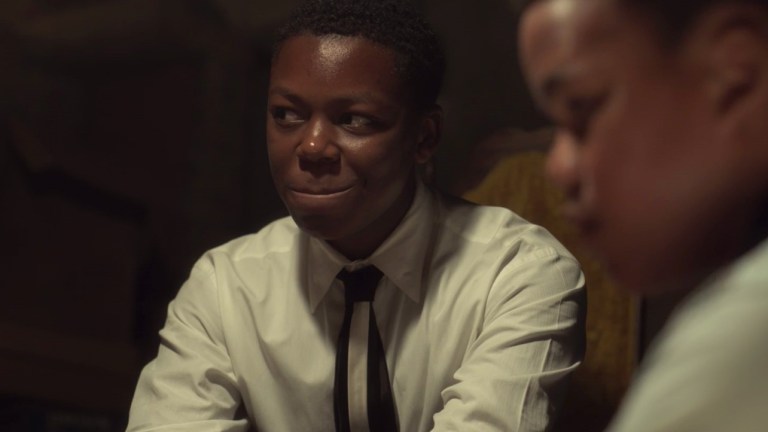Lovecraft Country and the Legacy of Emmett Till
Lovecraft Country evokes the true-life story of Emmett Till to emotionally anchor its monstrous latest episode.

The following contains spoilers for Lovecraft Country episode 8.
We meet young Emmett Till in episode three of Lovecraft Country, “Holy Ghost.” Till, referred to as “Bobo” and portrayed by Rhyan Hill, is seen using a Ouija board in Leti’s basement the night of her housewarming, alongside Diana (Jada Harris), and Gil (Scott-Heron, played by Maceo Smedley). The kids take turns asking questions, which the board answers, and when Bobo asks if he’ll have a good time on his trip, the board says no. It’s a brief moment in the story, but the meaning becomes much deeper once you realize that it’s the summer of 1955 and the trip in question is his visit to Mississippi to visit relatives.
Emmett Till was a real person and he was 14 years old when he travelled to the Mississippi Delta in late summer to visit family. On Aug. 24, 1955, Till, his cousins, and some friends went to Bryant Grocery in Money, Miss. to purchase refreshments, like kids are wont to do. According to the white woman working behind the counter, Carolyn Bryant, Till accosted her. One version of the story suggests he touched her hand and asked her for a date. Later testimony suggests he grabbed her hips, saying with some vulgarity that he’d been with a white woman before. When she went to her car to get a pistol, he supposedly wolf-whistled at her. Days later, her husband, Roy Bryant, and brother-in-law, J.W. Milam heard about the alleged incident, and decided Till needed to be taught a lesson.
On the night of Aug. 28, 1955, Bryant and Milam forcefully removed Till from the home of his great-uncle, Moses Wright. After abducting Till, they tortured him. They pistol whipped him, made him carry a cotton gin fan, stripped him naked, shot him, gouged out his eye. Then they tied the fan to him with a barbed wire that was wrapped around his neck, and tossed it, and him, into the Tallahatchie River. 72 hours later, his mutilated body was found floating 8 miles downriver. He was only recognizable by a ring he was wearing which had belonged to his father.
After Till’s body was found, his mother, Mamie Till-Mobley, insisted he be returned to Chicago for burial. She opted for an open-casket funeral, saying, “I think everybody needed to know what had happened to Emmett Till.” This is where ‘Jig-A-Bobo’ opens, with Diana in line to view Bobo’s body, while the stench of death fills the humid Chicago air. Fifty thousand people are estimated to have viewed Till’s disfigured body in-person, and graphic photographs of his corpse were published in the Chicago Defender and Jet magazine.
Milam and Bryant were tried for kidnapping and murder, and their trial began on Sept. 19, 1955. A mere five days later, after only an hour of deliberation, the men were acquitted by an all-male, all-white jury. The acquittal caused international outrage, and garnered interest in the NAACP. It inspired Rosa Parks to stay seated on a bus in Alabama, and ultimately helped spark the Civil Rights Movement.
A year after the trial, protected by double jeopardy laws, Bryant and Milam confessed to savagely murdering Emmett Till. They recounted the details to Look magazine, for which they were compensated $4000. Despite the initial support they received during the trial, the brothers-in-law were ostracized after detailing their heinous crime—the bare minimum of what they deserved. Carolyn also eventually recanted her testimony, telling Timothy Tyson—author of The Blood of Emmett Till— about Till’s alleged harassment, “That part’s not true.” She’s also reported to have said, “Nothing that boy did could ever justify what happened to him.” For the full story on Emmett Till, it’s worth watching the PBS documentary The Murder of Emmett Till.
Nothing Emmett Till did could ever justify what happened to him… and yet. That is the real horror of American racism, and that is what Lovecraft Country explores week to week. Blackness alone is justification enough to be assaulted or killed, something we’re unfortunately reminded of on a depressingly regular basis. Bobo’s transgression was merely existing while Black, and he was punished for failing to put himself beneath Whiteness—failing to “know his place, a fact that is reiterated by his killers’ own admission. His story fits within Lovecraft Country because the show is committed to depicting the horror and violence of anti-Black racism, and his story is more horrific and terrifying than anything writers can make up.
Nobody served time for the murder of Emmett Till. Both Roy Bryant and J.W. Milam died of cancer, (in 1994 and 1981, respectfully). It was probably slow and hopefully painful, but not nearly as satisfying as the kind of immediate justice we get in Lovecraft Country. That’s the appeal of this show for Black folks, we get to see our tormentors punished in real-time. We don’t have to wait years or decades for a white perpetrator to get their karmic due, it happens swiftly, and often with the appropriate level of violence. What’s more, Black characters come away stronger, more powerful, and better capable of protecting themselves and each other.
Emmett Till’s life ended horribly, and nothing will make his death less of a tragedy. But from that loss, came resistance. Black folks turned their pain into power. And Lovecraft Country reminds us that we are more than our trauma, and capable of empowering ourselves.